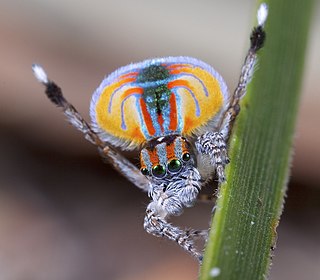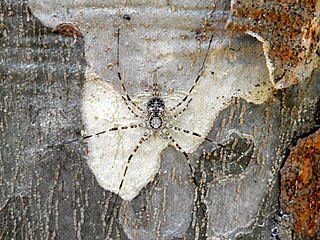
Ground spiders comprise Gnaphosidae, the seventh largest spider family with nearly 2,000 described species in over 100 genera distributed worldwide. There are 105 species known to central Europe, and common genera include Gnaphosa, Drassodes, Micaria, Cesonia, Zelotes and many others. They are closely related to Clubionidae. At present, no ground spiders are known to be seriously venomous to humans.

Ant spiders are members of the family Zodariidae. They are small to medium-sized eight-eyed spiders found in all tropical and subtropical regions of South America, Africa, Madagascar, Australia-New Guinea, New Zealand, Arabia and the Indian subcontinent. Most species are daytime hunters and live together with ants, mimicking their behavior and sometimes even their chemical traits. Although little is known about most zodariids, members of the genus Zodarion apparently feed only on ants; a number of other genera in the family are apparently also ant specialists.

Hersiliidae is a tropical and subtropical family of spiders first described by Tamerlan Thorell in 1870, which are commonly known as tree trunk spiders. They have two prominent spinnerets that are almost as long as their abdomen, earning them another nickname, the "two-tailed spiders". They range in size from 10 to 18 mm long. Rather than using a web that captures prey directly, they lay a light coating of threads over an area of tree bark and wait for an insect to stray onto the patch. When this happens, they encircle their spinnerets around their prey while casting silk on it. When the insect is immobilized, they can bite it through the shroud.

Jotus is a spider genus of the family Salticidae, native to Australia, New Zealand, and Indonesia. There are thought to be many as yet undescribed species in southern Australia.

Maratus is a spider genus of the family Salticidae. These spiders are commonly referred to as peacock spiders due to the males' colorful and usually iridescent patterns on the upper surface of the abdomen often enhanced with lateral flaps or bristles, which they display during courtship. Females lack these bright colors, being cryptic in appearance. In at least one species, Maratus vespertilio, the expansion of the flaps also occurs during ritualised contests between males. The male display and courtship dance are complex, involving visual and vibratory signals.

Prodidominae is a spider subfamily, sometimes called long-spinneret ground spiders. It was formerly regarded as a separate family, Prodidomidae, which was reduced to a subfamily of the Gnaphosidae in 2018.

Hersilia, also known as long-spinnered bark spiders and two-tailed spiders, is a genus of tree trunk spiders that was first described by Jean Victoire Audouin in 1826. Their nicknames are a reference to their greatly enlarged spinnerets.
Tama novaehollandiae or Tamopsis novaehollandiae are names used for an Australian spider species. However, the original type specimen has been lost, and it is not clear which, if any, of the many species of Tamopsis now recognized the name refers to, so it is treated as a nomen dubium. Tamopsis is placed in the family Hersiliidae.

Tamopsis is a genus of tree trunk spiders that was first described by B. Baehr & M. Baehr in 1987. Like other members of the family, they may be called two-tailed spiders, referring to two elongated spinnerets. The name is derived from the genus Tama and the Ancient Greek ὄψις (-opsis), meaning "resembling".

Tamopsis brisbanensis is a species of spider in the family Hersiliidae, found in Australia. It is sometimes called the Brisbane two-tailed spider. It is one of a large number of new Tamopsis species described by Barbara Baehr and Martin Baehr between 1987 and 1998.
Hersilia tibialis is a species of spider of the genus Hersilia. It is native to India and Sri Lanka.
Murricia is a genus of tree trunk spiders that was first described by Eugène Simon in 1882.

Neotama is a genus of tree trunk spiders that was first described by M. Baehr & B. Baehr in 1993.
Promurricia is a monotypic genus of Asian tree trunk spiders containing the single species, Promurricia depressa. It was first described by M. Baehr & B. Baehr in 1993, and has only been found in Sri Lanka.
Leichhardteus is a genus of Australian corinnid sac spiders first described by B. C. Baehr & Robert Raven in 2013.
Tasmanicosa is a genus of spiders in the family Lycosidae. It was first described in 1959 by Roewer. As of 2017, it contains 14 species, all from Australia.
Masasteron is a genus of spiders in the family Zodariidae. It was first described in 2004 by Baehr. As of 2017, it contains 21 Australian species.
Barbara Baehr is a research scientist, entomologist, arachnologist, and spider taxonomist. She has described over 400 new spider species, mostly from Australia. She is originally from Pforzheim, Germany.
Murricia uva is a species of hersiliid in the spider family Hersiliidae. It is found in a range from Cameroon to Uganda.








